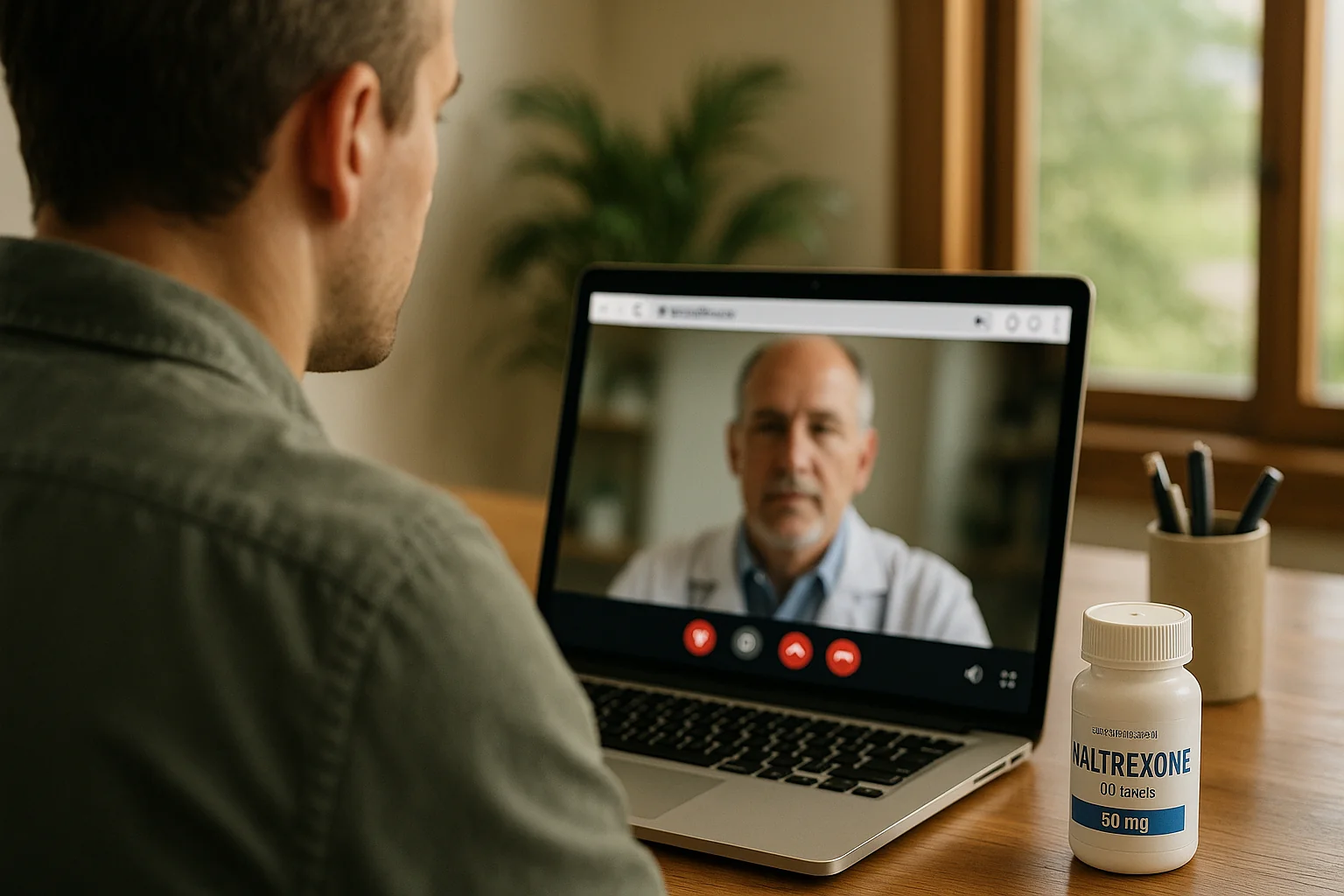A 2 minute assessment to get a personalized mental health or alcohol recovery plan.
Naltrexone telehealth removes the barriers—travel, stigma, waitlists—that keep millions of Americans from accessing the FDA-approved medication proven to reduce heavy drinking days.
What You'll Discover:
- Why naltrexone works and what the research shows
- The complete step-by-step telehealth process
- Daily versus targeted dosing (and which fits your life)
- Common side effects and important safety considerations
- What to expect in your first weeks and months
- How virtual care compares to in-person treatment
The first thing to know is this: naltrexone, the FDA-approved medication for alcohol use disorder, can now start with a simple virtual visit. Your medication arrives discreetly at your door, and you get ongoing support—all without clinic logistics or waiting weeks for an appointment.
Among FDA-approved medications for alcohol use disorder, oral naltrexone has the strongest evidence backing it. A large systematic review of 118 trials found clinically meaningful benefits, with a Number Needed to Treat of around 10-12. That means for every 10-12 people who take naltrexone, one additional person avoids heavy drinking compared with placebo—a solid effect in real-world terms.
All that said, roughly 29.5 million U.S. adults meet criteria for alcohol use disorder in a given year, yet only a small fraction ever receive medication treatment. Telehealth is changing that by lowering barriers and meeting people where they are.
How Naltrexone Actually Works
So, what does naltrexone actually do? The short answer is: it changes how rewarding alcohol feels.
Naltrexone works by blocking certain receptors in your brain. When you drink alcohol, your brain normally releases natural "feel-good" chemicals called endorphins, which then trigger a surge of dopamine—the chemical that creates that buzz you're chasing. Naltrexone blocks those endorphins from attaching to their receptors, which means much less dopamine gets released when you drink.
For many people taking naltrexone, this shows up as less "pull" toward that second or third drink. You can take it or leave it. The obsessive thinking about alcohol quiets down. And most importantly, you have fewer heavy-drinking days—the pattern that causes most of the medical and life problems.
What naltrexone doesn't do: It won't make you sick if you drink (that's a different medication called disulfiram). It doesn't erase all urges—habits and triggers still exist, which is why support and skills matter. And it doesn't treat pain—in fact, it blocks pain medications, which is an important safety consideration.
Where naltrexone fits best: If your goal is to moderate your drinking or cut back dramatically, naltrexone is often the top choice. If you're already abstinent and want help staying that way, other approaches may work equally well or better. Your clinician can help you figure out the best fit based on your drinking patterns and goals.
Major medical guidelines, including those from the American Psychiatric Association, recommend naltrexone as a first-line treatment option for alcohol use disorder.
The Telehealth Process: What Actually Happens
With that in mind, here's exactly what the process looks like with Choose Your Horizon, a fully virtual naltrexone program designed around convenience, safety, and support.
Step 1: Quick Confidential Assessment
You start by answering a short online assessment—usually takes about five minutes. You'll answer questions about your drinking patterns, your goals (moderation or abstinence), your medical history, and any medications you're currently taking. This helps determine if naltrexone is a good fit for you.
Step 2: Virtual Visit with a Clinician
Within the same week, you'll have a virtual visit with a psychiatrist or addiction medicine specialist. During this visit, the clinician will confirm you're a good candidate for naltrexone, discuss your options for dosing (more on that below), and screen for any contraindications like current opioid use, severe liver disease, or pregnancy.
This isn't a judgment session—it's a medical consultation where you get to ask questions and understand how the medication works. The clinician will help you choose between daily dosing or targeted dosing (sometimes called the Sinclair Method), depending on your drinking patterns and what fits your lifestyle.
Step 3: Medication Delivered to Your Door
Once your prescription is approved, your naltrexone is shipped discreetly to your home. Choose Your Horizon typically uses 50 mg oral tablets, though you can start at 25 mg if you're sensitive to medications or prone to nausea. Refills happen automatically on a quarterly schedule, so you don't have to remember to reorder.
No pharmacy counter. No awkward conversations. Just discreet packaging that arrives at your doorstep.
Step 4: Ongoing Support and Coaching
This is where telehealth really shines. You'll get access to weekly support groups, optional one-on-one coaching, and something unique—the Aurora AI Naltrexone Coach. It's HIPAA-compliant with zero data retention, available 24/7 to give you real-time tips, adherence reminders, and help with planning for high-risk situations.
Think of it as having a coach in your pocket for those "what do I do right now?" moments when a craving hits or you're heading to a social event where everyone will be drinking.
Step 5: Follow-Ups and Adjustments
Your care team tracks your progress—how strong your cravings are, how many drinking days you're having, any side effects you're experiencing. During the first three months, they'll optimize your plan based on what's working and what's not. After that, they help you maintain your gains and provide ongoing support for as long as you need it.
Daily Dosing or Targeted Dosing: Which Is Right for You?
So, which dosing approach should you choose? That depends on your drinking patterns and lifestyle.
There are two main evidence-informed approaches to taking oral naltrexone, and both are supported by clinical guidelines. Your clinician will help you pick the best fit based on your goals, schedule, and medical history.
Daily Dosing (The Most Common Approach)
With daily dosing, you take 50 mg of naltrexone every morning—many people start at 25 mg for the first week to minimize side effects, then increase to 50 mg. This approach works best when your drinking is frequent or unpredictable, because the medication provides steady coverage. You're protected whether you drink or not, which means you don't have to plan ahead or worry about forgetting to take it before a spontaneous happy hour.
The daily approach also helps reduce overall cravings throughout the day, not just when you're actively drinking. Many people find this makes staying on track easier.
Targeted Dosing (The Sinclair Method)
With targeted dosing, you take 50 mg about one hour before you plan to drink. This approach works well if you have clear drinking windows—for example, you mainly drink on weekends or at specific social events—and your goal is moderation rather than abstinence.
The key rule with targeted dosing is this: never drink without taking naltrexone first. If you skip doses before drinking, you can re-sensitize your brain's reward system to alcohol, essentially undoing the progress you've made. Consistency is crucial.
Some people prefer this approach because they only take medication when they need it, and it feels more flexible. Others find daily dosing simpler because they don't have to remember to plan ahead.
Either way, you're working with proven science. Your clinician will help you decide which approach fits your life and drinking patterns best.
Side Effects and Safety Considerations
Like any medication, naltrexone comes with potential side effects and important safety considerations. The good news is that most side effects are mild and temporary.
Common Side Effects (Usually Fade Within 1-2 Weeks)
The most common side effect is nausea or queasiness, especially in the first week. Taking naltrexone with breakfast significantly helps—food in your stomach reduces the likelihood of nausea. Some people also experience mild headaches or light fatigue, and a small number of people report more vivid dreams than usual.
If nausea is bothering you, starting at 25 mg for the first week often solves the problem. Most people find these side effects fade quickly as their body adjusts to the medication.
Important Safety Cautions
Opioid medications: This is the most critical safety consideration. Naltrexone blocks all opioids—both prescribed pain medications and illicit opioids. If you're currently taking opioid pain medications, you'll need to stop them before starting naltrexone and work with your doctor on alternative pain management. If you need surgery or dental work that might require opioid pain control, tell your surgical team you're on naltrexone well in advance. There are safe workarounds, but planning is essential.
Liver health: Naltrexone is processed by your liver, so liver function matters. Many people with alcohol use disorder have mildly elevated liver enzymes, which often improve as you cut back on drinking. But if you have active, severe liver disease, naltrexone may not be appropriate. Your clinician may check baseline liver function tests and monitor them periodically, especially in the first few months.
Pregnancy and breastfeeding: Naltrexone isn't typically the first choice during pregnancy or breastfeeding. If you're pregnant, planning to become pregnant, or breastfeeding, discuss the risks, benefits, and alternative options with your clinician.
Drug interactions: Naltrexone itself has relatively few drug interactions, but your complete medication list matters. Be sure to tell your clinician about everything you're taking, including over-the-counter medications and supplements.
The important thing to know is that telehealth prescribers screen for the same safety issues an in-person clinic would. If naltrexone doesn't fit your situation, they'll discuss other evidence-based options recommended in medical guidelines from SAMHSA.
What to Expect: Your Realistic Timeline
One of the most common questions people ask is: when will I see results? Here's an honest timeline based on clinical experience and research.
Week 1-2: The Adjustment Period
In the first couple weeks, many people notice that cravings feel less magnetic. Some describe it as a "mental gap" that appears between the urge to drink and actually reaching for a drink—suddenly there's space to pause and choose. If you experience nausea, it usually doesn't last long, especially if you take naltrexone with food or start at the lower 25 mg dose.
This is a good time to set up simple structures: stay hydrated, eat protein with your meals, wind down without screens before bed, and aim for eight hours of sleep. These basics support your brain as it adjusts.
Week 3-4: Heavy Drinking Days Start to Drop
This is typically when people see their heavy-drinking days decrease noticeably. Many report stopping at one or two drinks when they used to have four or five, or skipping drinking days altogether when they would have previously felt pulled to drink.
You'll start fine-tuning your approach during this period: Do I need a different routine after work? What's my plan for Friday nights? Who can I text when I'm tempted? Building these practical strategies matters just as much as the medication.
Month 2-3: Optimizing Your Plan
By the second and third month, you and your care team will optimize the details—whether daily or targeted dosing works better, how to handle weekends and social situations, what your go-to phrases are when someone offers you a drink. You might adjust your sleep routine, identify your stress triggers, and build in more healthy coping strategies.
Expect incremental gains during this period. This is behavior change plus brain chemistry working together—both matter. Some weeks will feel easier than others, and that's completely normal.
Beyond 90 Days: Maintaining What Works
Evidence-based programs typically recommend staying on naltrexone for at least three to four months, and many people continue longer if it's helping them maintain the life they want. The good news is that naltrexone doesn't create dependence or addiction—it's not a medication you'll struggle to stop.
When you're ready, you can taper off with your clinician's guidance, usually after a sustained period of low-risk drinking or abstinence. Some people stay on it for six months, others for a year or more. The timeline depends on your individual progress and goals.
Research from major studies shows that combining medication with even brief support significantly improves outcomes compared to either approach alone.
Telehealth vs. In-Person: What's Different?
So, how does telehealth compare to traditional in-person treatment? The short answer is: the medical care is identical, but the logistics are easier.
What's the Same
The medical standards are identical. You get the same thorough safety screening, the same careful consideration of dosing options, and the same quality of follow-up care. Telehealth providers follow the same clinical guidelines that in-person clinics use.
What's Easier with Telehealth
No travel time or waiting rooms—you can do your appointments from home during a lunch break. Your medication is shipped discreetly, so there's no pharmacy counter interaction or concern about running into someone you know. You can often start within days instead of waiting weeks or months for an appointment slot. And you get digital tools like tracking apps, reminder systems, and AI coaching that keep you engaged between appointments.
For many people, the privacy and convenience of telehealth make it easier to actually follow through with treatment.
What Some People Prefer About In-Person
If you want same-day lab work done on-site, or if you prefer having all your care integrated under one roof with your primary care doctor, in-person treatment might feel more straightforward. And if you already have a relationship with a local addiction specialist you trust, continuing with them makes sense.
The bottom line: either path can be excellent. Choose the one you'll actually stick with. The best treatment is the one you use consistently, and for many people, that means removing as many barriers as possible—which is exactly what telehealth does.
Common Questions About Naltrexone Telehealth
Will naltrexone make me sick if I drink?
No. That's a common misconception, probably because people confuse naltrexone with disulfiram (Antabuse), which does cause an unpleasant reaction when you drink. Naltrexone simply reduces the rewarding feeling you get from alcohol—it doesn't make you physically ill.
Can I still choose abstinence if I'm taking naltrexone?
Absolutely. Many people use naltrexone to support complete abstinence. Others use it to stop heavy-drinking episodes and gradually move toward either low-risk drinking or eventual abstinence. Both are valid goals, and naltrexone supports either path.
Do I need to get lab work done?
Your clinician will decide based on your medical history and symptoms. Many people can start naltrexone safely without immediate lab work. Others—especially those with a history of liver problems or who have been drinking heavily for years—benefit from baseline liver function tests and periodic monitoring. Your clinician will guide you on what makes sense for your situation.
What if I need surgery or pain control later?
This is an important consideration. If you need surgery or dental work, tell your surgical team and anesthesia providers that you're taking naltrexone well in advance. They'll need to plan alternative pain management strategies since naltrexone blocks opioid pain medications. There are safe workarounds—they just require planning.
How long do people typically stay on naltrexone?
Most commonly, people stay on it for three to six months or longer. Some people continue for a year or more if the benefits remain strong and they feel it's helping them maintain their goals. Because naltrexone doesn't cause dependence, you can stop when you're ready with your prescriber's guidance—usually after a sustained period of stable, low-risk drinking or abstinence.
When is the right time to start?
When alcohol is costing you—time, energy, money, sleep, relationships, or peace of mind—and you're ready for an approach that has solid research behind it. There's no perfect moment, but there is a right moment: when you're ready to try something different.
Your 90-Day Action Plan
Here's a practical roadmap you can follow for your first three months on naltrexone. Think of this as a template you can adapt to fit your life.
Days 1-7: Building Your Foundation
Start your naltrexone—either 50 mg daily from the beginning, or 25 mg for the first few days if you want to ease into it. Take it with breakfast to minimize nausea. Pick two daily anchors to build around: a nightly wind-down routine without screens, and a protein-rich breakfast every morning.
Write out two simple scripts you can use when someone offers you a drink: "No thanks, I've got an early morning tomorrow," and "I'm pacing myself tonight." Having these ready removes the need to think in the moment.
Days 8-30: Tracking Your Progress
Start tracking your heavy-drinking days so you can see the trend line moving down. Work with your clinician to confirm whether daily dosing or targeted dosing is working better for you. Add one weekly touchpoint—either a support group or a coaching check-in—to your schedule. Identify one friend you can put on speed-dial for Friday and Saturday nights when you might need support.
Days 31-60: Fine-Tuning the Details
Focus on the hard moments: After work? Weekends? Travel? Figure out what triggers your drinking urges and build specific strategies for each one. Add one social swap to your routine—maybe a mocktail bar, a hiking meetup followed by coffee, or a morning workout class. If nausea or other side effects are lingering beyond the first month, talk to your clinician about adjusting your dose or timing.
Days 61-90: Consolidating Your Wins
Look at what's working and what's not. Schedule proactive check-ins with your care team to avoid hitting a plateau. Decide on your next phase: continue at the current dose, taper gradually, or maintain with less frequent follow-ups. Celebrate the non-scale victories—better sleep, calmer mornings, more money in your account, improved relationships.
Staying Within the Evidence
Major medical organizations agree: medication should be offered as a first-line treatment for alcohol use disorder, with therapy and support alongside it. This isn't fringe medicine—it's mainstream, evidence-based care recommended by the American Psychiatric Association and SAMHSA.
The effects of naltrexone are what researchers call "moderate but meaningful." That means it's not a magic bullet, but it significantly improves outcomes, especially for reducing heavy-drinking days—the pattern that causes most of the harm.
The data also show clearly that pairing medication with even brief, skills-focused support improves both adherence and results. That's why Choose Your Horizon builds in coaching and groups rather than just sending you pills.
Finally, be patient with yourself. Alcohol use is a learned pattern supported by brain chemistry. Naltrexone helps retrain that chemistry, but your routines, environment, and coping skills finish the job. Progress isn't always linear, and that's okay.
Ready to Take the Next Step?
If you're curious whether naltrexone telehealth could fit your life, there's no need to guess or wonder. A quick, confidential assessment will help you see where you stand and what a personalized plan might look like—with options for daily or targeted dosing, built-in coaching support, and discreet home delivery.
No pressure. No perfection required. Just a clear, evidence-based next step that puts you back in control.
References
- JAMA: Comprehensive review and meta-analysis showing naltrexone reduces heavy-drinking days
- NIAAA: Alcohol use disorder prevalence and statistics
- APA: Clinical practice guideline for pharmacological treatment of alcohol use disorder
- SAMHSA: Medication for the treatment of alcohol use disorder—brief guide for clinicians and patients




